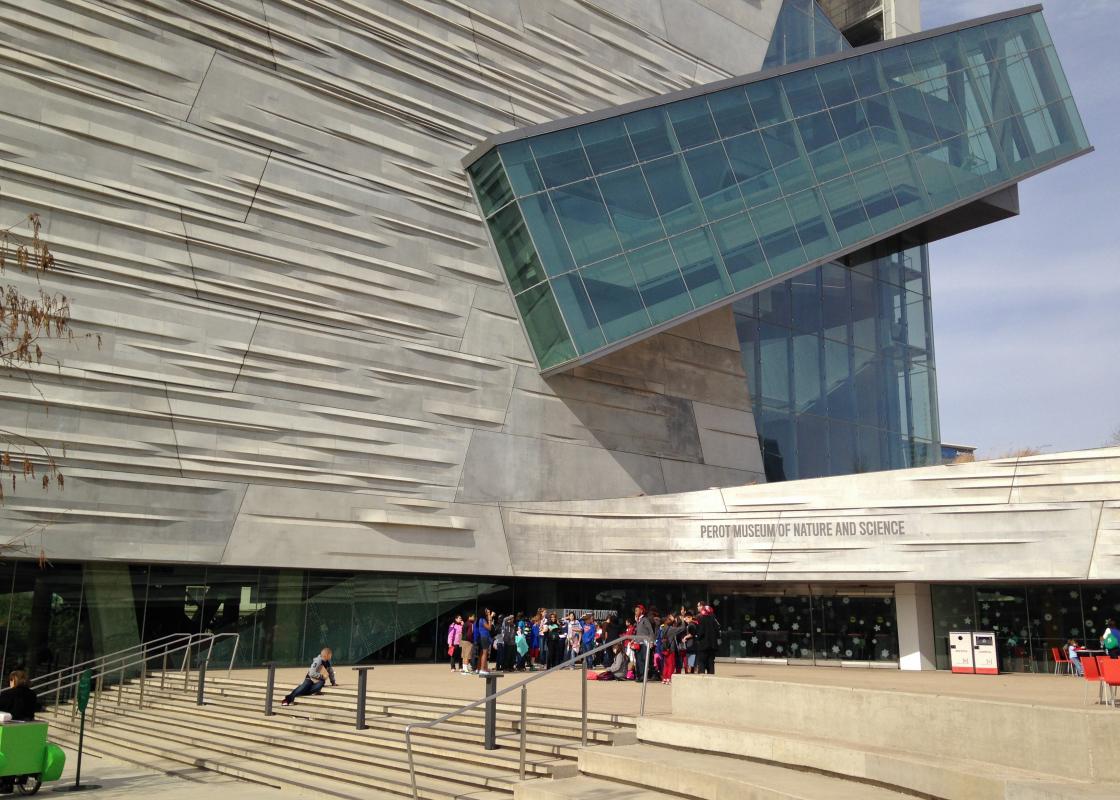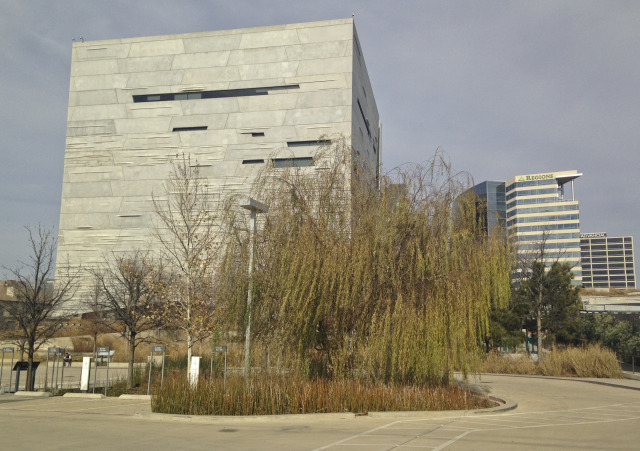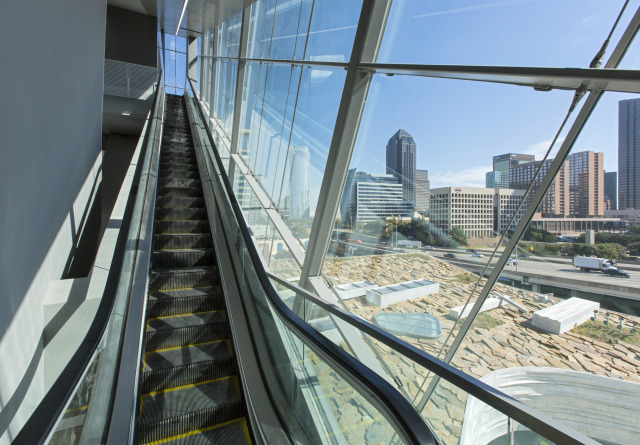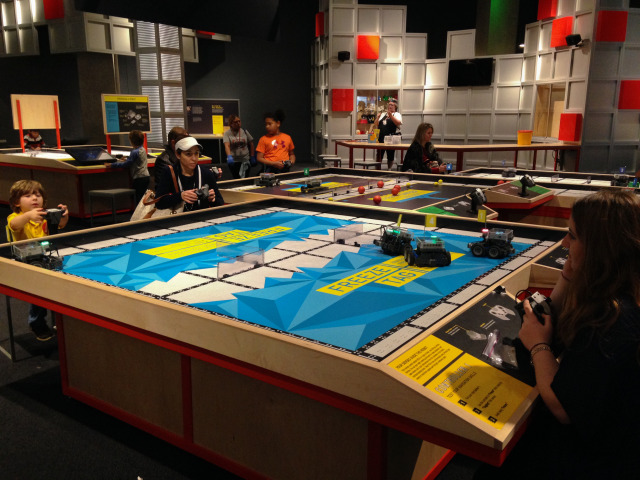Follow OffCite's State of Museums series that supplements the new issue of Cite. Use the hashtag #StateOfMuseums to view related content on Twitter, Instagram, and Facebook.
The critics, guys who are paid by major American newspapers to have opinions about buildings, haven't always been crazy about the one that Morphosis designed for the new home of the Perot Museum of Nature and Science in Downtown Dallas.
When the museum opened in 2012, Los Angeles Times architecture critic Christopher Hawthorne panned it as “a thoroughly cynical piece of work,” arguing that the “largely windowless crypt” is “marked by civic aloofness” and “cartoon menace” and “uses a frenzy of architectural forms to endorse the idea that architecture, in the end, is mere decoration.”
Mark Lamster of the Dallas Morning News wrote that the building “looks like nothing so much as a boxy spaceship arrived from the faraway galaxy of Starchitecturas Major.”
When I visited earlier this year, I was thinking about the building in a different way. I was coming at it not as a professional critic but as an ordinary user. What, I wondered, might a 10-year-old have to say about it? I tried to imagine how I might have reacted as my classmates and I scrambled out of the school bus and ran toward it. Maybe it’s different for Angelenos and Dallasites who are used to big buildings. I grew up in a rural town in Indiana, where one destination for a field trip was our community wastewater treatment facility. At least we were able to walk to it. I remember nothing so much as trying my best to hide my need to gag from the stench. I didn’t want Mr. Novy to think I was ungrateful.
In truth, that 10-year-old kid must still have some sway over my aesthetic judgment, because I let out a low whoa when I approached the museum. I had no idea what I was looking at. Lamster’s right: It absolutely looks like it’s from a faraway galaxy. It could have been the docking station where the Millennium Falcon refuels. Or the Olympic Stadium for the 2036 Anti-Gravity Games. Still, as right as Hawthorne is about the risk of "civic aloofness" and associated problems with look-at-me architecture, the alienness of the Perot Museum seems a kind of virtue. This isn't architecture you can get used to. And I don’t think that that’s the worst thing for a museum of nature and science to be. What better way to inspire (or, maybe, require?) visitors to explore and to wonder?
Even Morphosis co-founder Thom Mayne, who was awarded the Pritzker Prize in 2005, gets that. "From a distance," he conceded in a phone interview, "[the museum] looks like an imposing box."
You first see this box, the equivalent of a 14-story building, looming next to the elevated freeway. Sitting on a plinth, it has a bumpy skin of precast concrete panels that resembles a kind of futuristic imperial armor. Grafted on to the side is a great glass arm that houses the museum's 54-foot escalator. You almost expect an escape pod to crash out the top of it and shoot away toward the relative safety of Plano.
It is imposing. "[The Perot] has a very different mission from a modern art museum," says Mayne. "It's about advancing inquisitiveness." CEO and Director Colleen Walker echoed that: "It invites you to explore. You're not the same person when you get out of the car and reach the front door. You get off the freeway and you transform."
Public parking is located underneath that freeway. You cross the feeder road to begin a tightly controlled entry sequence. A curving concrete retaining wall shields you from the traffic as you approach the museum along a covered path framed by wild grasses and bamboo plants. I'm no Trekkie, but I imagined myself as a kind of captain inching forward until the alien planet made itself familiar to me. A stream rolled underfoot. Evidence of other humans gradually appeared: a family banged on xylophones made out of painted pipes; kids jumped over supersized neon frogs.
Inside, you can see what Mayne means when he says that he wanted the building's engineering to serve the museum as an additional "implicit exhibit." You see wall-sized panes of structural glass, forearm-thick steel cables, heavy Y-shaped support beams, even the innards of the elevators. Everything, it seems, is on display.
The building is divided into a massive vertical (and vertiginous) space for circulation in the front and flatter, darker exhibition spaces tiering off on each of the five floors. Much has been made about that escalator, encased in a 150-foot glass tube, rolling users into a view of the Arts District on the other side of the freeway.
Somehow, I missed it and ended up taking the regular old stairs. As you climb, you're delivered to a landing next to the elevator bank, and then you're led through the horseshoe-shaped exhibition spaces all the way back around to the landing. Then you climb again. You quickly fall into a pattern: Take the stairs up, loop through. Up and through. It's almost like knitting. Mayne says that he wanted the circulation spaces to work as "connective tissue" separating the users' movements from the exhibits themselves. Here, though, Hawthorne's criticism seems apt: “On every floor you get a clear sense of leaving the architecture to enter the galleries, and leaving the galleries to return to the architecture.”
But the galleries, as I might have said as a 10-year-old boy, are totally awesome. They were co-designed by separate teams from Boston and Austin. Everywhere you look is some interactive gizmo or digital lever or irresistible button. It is overwhelming. Besides the requisite dinosaur bones, seriously verisimilutudinous dioramas, and cavern-like arrays of geodes and glowing crystals, there's an earthquake simulator and a tornado simulator. There's a touchscreen kiosk where you can design your own bird. On one floor, approaching a kind of domed holographic vortex that I thought might be a wormhole, I heard instead the unmistakable drawl of Owen Wilson narrating a lesson about protons, neutrons, and electrons. Even the staircases are in on it: The last 12 steps leading to the basement are tuned to the notes on the chromatic scale. I was reminded of Tom Hanks's character in Big dancing out "Chopsticks" at F.A.O. Schwarz. I ended my visit watching people “race” a cheetah and Kansas City Chief Jamaal Charles, projected behind them on a 55-foot screen, in the Lamar Hunt Family Sports Hall.
Getting out isn't as much fun as getting in. Leaving the galleries to enter the architecture, to borrow's Hawthorne phrase, and then leaving the museum to re-enter the city, creates a kind of negative progression. You retreat from the noisy, immersive, kinetic quality of the exhibitions to the chilly alienness of the surfaces of the architecture, and you end up standing in a parking lot, waiting to cross a busy feeder road to get to another parking lot. The transition to the museum feels wonderfully strange; the transition from feels strangely awkward. Leaving, you get a sense that the gaps between the galleries and the architecture mirror the gaps between the building and rest of the city.
Walker explains that the Perot Museum does sit in the path of a planned DART line. And there's a bit of new wayfinding outside the Perot in the form of a thin green line painted on the sidewalk of the feeder road leading visitors to nearby Klyde Warren Park, which then connects to the rest of the Arts District on the other side of the freeway. For now, though, that line seems like a blind, if hopeful, umbilical cast out from this "boxy spaceship" in search of a connection. "Dallas is learning to be a pedestrian city," says Walker. "But much of our cultural infrastructure was built in the last 10 to 15 years." Houston, too, is learning. As the proposed expansions of the Menil Collection and MFAH suggest, it's not enough anymore in either of these cities to hire an award-winning architect to build a designer building. We want our award-winning architects' designer buildings to create connections within, and between, our neighborhoods; we want our experiences to feel of a whole. We want not just spaceships but galaxies, too.













